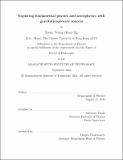Exploring fundamental physics and astrophysics with gravitational-wave sources
Author(s)
Ng, Kwan Yeung (Ken)
DownloadThesis PDF (5.396Mb)
Advisor
Vitale, Salvatore
Terms of use
Metadata
Show full item recordAbstract
In this thesis, I investigate the new physics that can be learnt by the current and future gravitational wave (GW) observations. With the current observations, I study how multiple binary black hole (BBH) spin measurements can be combined by hierarchical Bayesian framework to search for ultralight bosons (e.g., axions). This search relies on the process called superradiance, in which boson clouds form around fast spinning black holes (BHs), reduce the BH spins to characteristic values, and lead to an exclusion region in the parameter space of BH mass and spin. Based on the second GW catalog released by LIGO-Virgo Collaboration, the measurements of BH masses and spins highly disfavor the bosons with masses [1.3, 2.7] × 10⁻¹³ eV and decay constants 𝑓𝑎 ≳ 10¹⁵ GeV. With the future observations, I explore the science goals of the next-generation ground-based GW detectors, namely, Cosmic Explorer and Einstein Telescope. These detectors may observe stellar-mass 𝒪(10 − 100 𝑀 subscript ⊙) BBHs up to 𝑧 ∼ 100, and hence tracing the cosmic merger rate history may become feasible. There are two intriguing BBH populations beyond 𝑧 ∼ 10 which are unreachable by the current detectors. The first possible population consists of astrophysical BBHs originated from the remnants of Population III (Pop III) stars, whose merger rate density may peak at 𝑧 ∼ 10 from the current astrophysical prediction. The second possible population is the assembly of primordial black hole (PBH) mergers, which are the relics of overdensities in the early Universe, and the merger rate density increases monotonically with redshifts. I perform mock data challenges to quantify the individual redshift measurements of high-redshift BBHs and reconstruct the merger rate density of each subpopulation with hierarchical analysis. Even with the redshift measurements alone, the next-generation detectors will provide precise measurements of the abundance of Pop III BBHs and PBHs with a few months of data, paving a new avenue for high-redshift GW astronomy.
Date issued
2022-09Department
Massachusetts Institute of Technology. Department of PhysicsPublisher
Massachusetts Institute of Technology